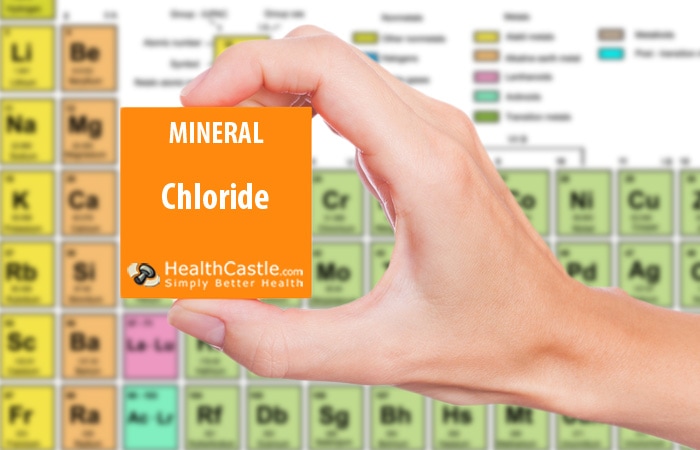
Written By: Carolyn Berry, RD
Title: Registered Dietitian
Alumni: University of British Columbia
Last Updated on:


Chloride is found in many chemicals and other substances in the body. It is needed to keep the proper balance of body fluids and is an essential part of digestive juices.
Table of Contents
The Dietary Reference Intakes (DRI) for chloride are shown below:
| Age Group | Recommended Dietary Allowance (RDA) per Day | Tolerable Upper Intake Level (UL) per Day * |
| Adults | ||
| 19 to 50 years | 2.3 g | 3.6 g |
| 51 to 70 years | 2.0 g | 3.6 g |
| 70 years and up | 1.8 g | 3.6 g |
| Kids and Youth | ||
| 1 to 3 years | 1.5 g | 2.3 g |
| 4 to 8 years | 1.9 g | 2.9 g |
| 9 to 13 years | 2.3 g | 3.4 g |
| 9 to 18 years | 2.3 g | 3.6 g |
| Special Considerations | ||
| Pregnant women 14 years and up | 2.3 g | 3.6 g |
| Lactating women 14 years and up | 2.3 g | 3.6 g |
Chloride travels primarily with sodium and water and helps generate the osmotic pressure of body fluids. It is an important constituent of stomach hydrochloric acid (HCl), the key digestive acid. Chloride is also needed to maintain the body’s acid-base balance. The kidneys excrete or retain chloride mainly as sodium chloride, depending on whether they are trying to increase or decrease body acid levels. Chloride may also be helpful in allowing the liver to clear waste products.
Excessive sweating, diarrhea or vomiting may cause a temporary loss of chloride, but actual deficiency is rare.
Toxicity is also rare, although dehydration may cause higher levels of chloride, which is easily alleviated by drinking fluids.
Chloride is found in table salt or sea salt as sodium chloride. Other common sources include yeast extracts, processed luncheon meats, cheeses, flavoured oatmeal, breakfast cereals, and other processed foods. For this reason, most North Americans probably get more chloride than needed
Foods naturally containing chloride include seaweed, rye, tomatoes, lettuce, celery, and olives.
Chloride, together with potassium, is also found in most foods and is usually the main ingredient of salt substitutes.
In the United States: The % daily value gives you an idea of how much chloride is in the food you eat. The Daily Value (DV) for chloride is 2,300 mg. The number you see on the Nutrition Facts label is a percentage calculated by dividing the amount of chloride in one serving of the food by the daily value. Chloride is not required to be listed on the Nutrition Facts Table, therefore it is often not listed.
In Canada: The Daily Value for chloride in Canada is also 2,300 mg. Chloride is not required to be listed on the Nutrition Facts Table, therefore it is often not listed.
Alumni: University of British Columbia – Carolyn Berry is a Vancouver-based Registered Dietitian, self-proclaimed foodie, marathon runner, and owner of Berry Nourished. Carolyn works in a variety of areas including clinical nutrition, outpatient counselling at Medisys Preventive Health Clinic, as a nutrition tour leader with Save-On-Foods, and in the media, including segments on CBC Television, CKNW and Spice Radio. Through informative and practical nutrition advice and her food-first approach to health, Carolyn fulfills her passion to empower others with knowledge about nutrition so that they can make the best decisions to improve their health. She strongly believes that food should be both healthful and delicious.
chloride, micronutrient - minerals, minerals, vitamins - minerals